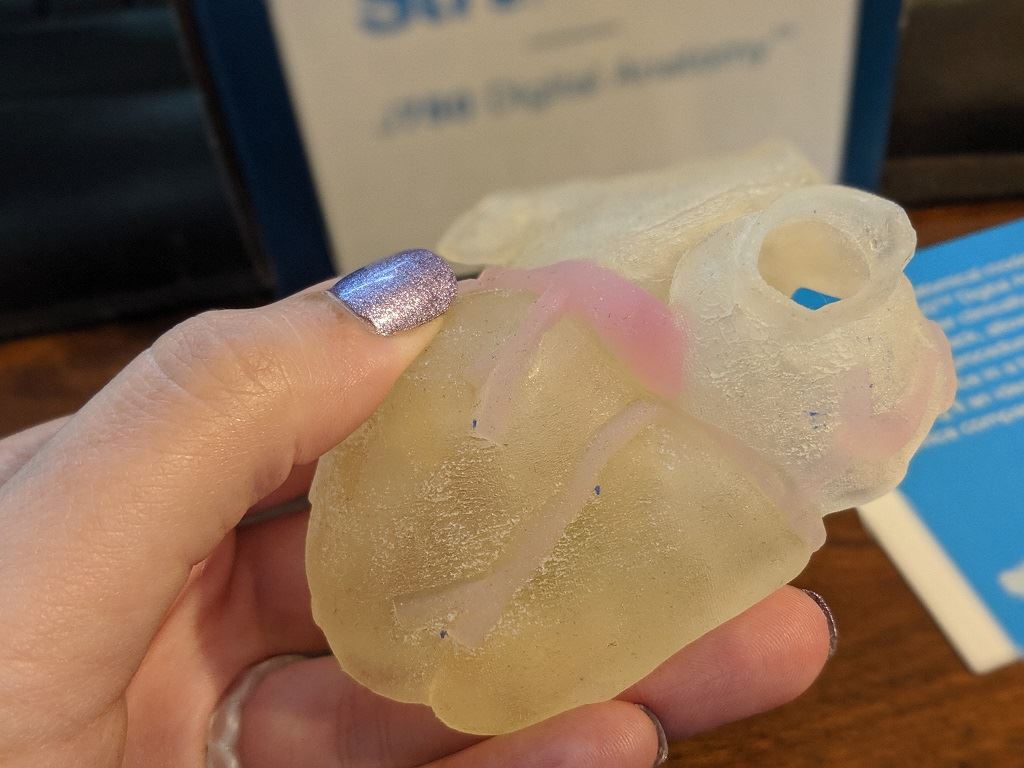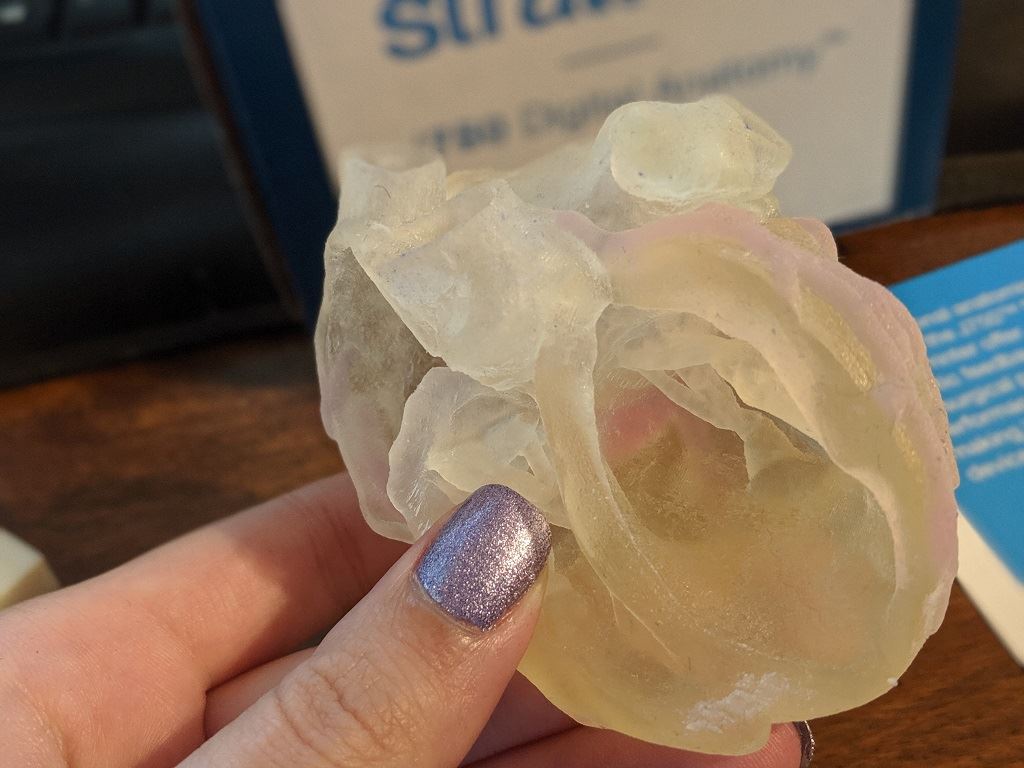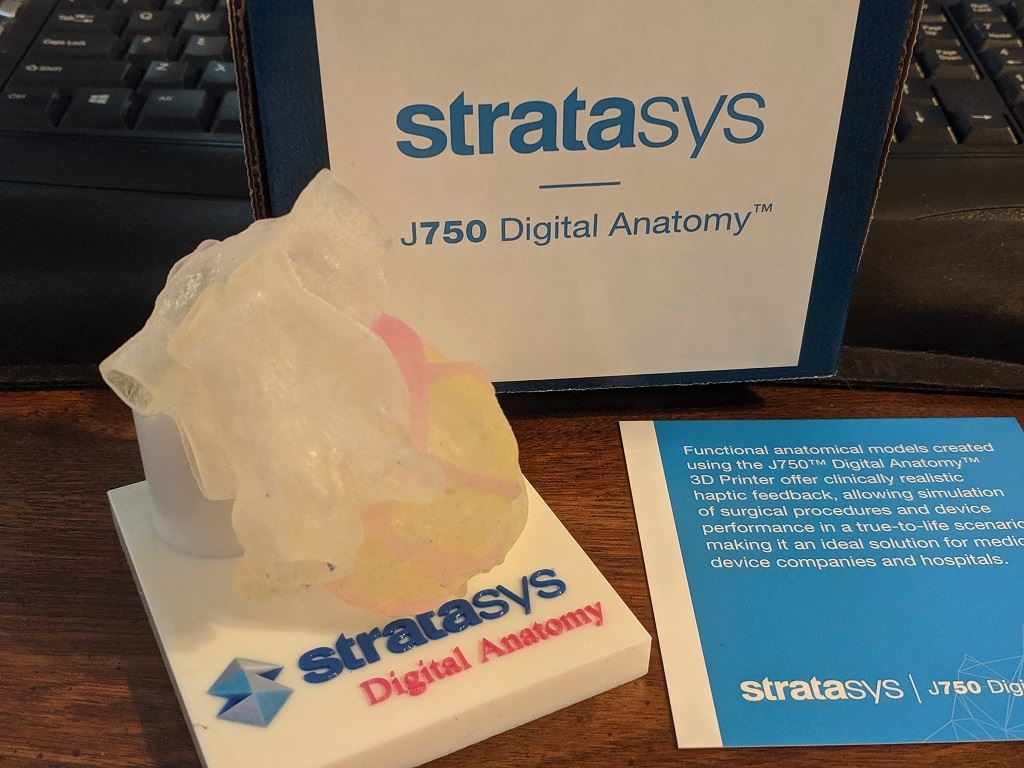![Cardiac model 3D printed on the J750 Digital Anatomy 3D printer using TissueMatrix and Agilus 30 materials to mimic the human heart [Image: Fabbaloo]](https://fabbaloo.com/wp-content/uploads/2020/05/DA_img_5eb08f3d3237d.jpg) Cardiac model 3D printed on the J750 Digital Anatomy 3D printer using TissueMatrix and Agilus 30 materials to mimic the human heart [Image: Fabbaloo]
Cardiac model 3D printed on the J750 Digital Anatomy 3D printer using TissueMatrix and Agilus 30 materials to mimic the human heart [Image: Fabbaloo]
Stratasys is unveiling a new Digital Anatomy portfolio to offer targeted functionality in healthcare 3D printing.
The announcement is indicative of a move to focus on key verticals in Stratasys’ 3D printing business — and a conversation with the team sheds light on much more to come.
Digital Anatomy Portfolio
![The J750 Digital Anatomy 3D printer [Image: Stratasys]](https://fabbaloo.com/wp-content/uploads/2020/05/DAJ750_img_5eb08f3d970bf.jpg)
I spoke with Scott Drikakis, Medical Segment Leader at Stratasys, for insights into just what is happening with this debut.
Viewing the strategy as centering on three tripod bases of key verticals — aerospace, automotive, and healthcare — for 3D printing, Drikakis noted that clearly we’re focusing today on healthcare. That he mentioned the strategic approach of solutions for specific verticals is also quite telling, so let’s not forget this: there will likely be similar launches in the not-too-distant future targeting aerospace and automotive applications.
But today, it’s healthcare, so into Digital Anatomy we dive.
“This is the first solution we are releasing for the market that has been specifically designed for the healthcare space, designed on feedback from healthcare customers and hospitals we currently work with today,” Drikakis told me.
“Solution” is a good word for it, as it is indeed a full set of introductions today, including a new 3D pritner, three new materials, and a software component.
And it’s only the beginning.
“This is just the start,” Drikakis continued. “We have launches planned for next year, early in the year. We have an extremely dialed in three-year plan, and a five-year plan we’ve been working on and will continue to increase the value proposition based on market dynamics.”
Digital Anatomy J750 3D Printer
![Introductory prints from the J750 in 2016 (left) and the J750 Digital Anatomy in 2019 (right) [Image: Fabbaloo]](https://fabbaloo.com/wp-content/uploads/2020/05/J750prints_img_5eb08f3defa65.jpg)
It starts, naturally, with the 3D printer.
Stratasys launched the multi-material, multicolor J750 3D printer in the spring of 2016. That launch was celebrated at Otterbox, best known for making tough cases for phones, as the J750 came into play there for advanced prototyping. It was an interesting event, highlighting some initial applications across a variety of industries, from those phone cases to automotive to a telescope to a shoe — to a detailed anatomical model. Anatomical models are becoming not just much more detailed with this specialized machine, but also more functional.
“Because this is based on our J750 platform, everything it can do is in addition to our standard J750. This is ‘in addition to’ instead of a niche 3D printer,” Drikakis explained. “We’ve talked before about visual models and capabilities of our standard J750 3D printer as it is available today, now we add the functionality piece with these new abilities and new materials.”
Available today, the new Digital Anatomy J750 is priced “in line with all J-series printers,” as will be the new materials, he added.
Digital Anatomy Materials


Hands-on with the 3D printed heart and a look into internal structures [Images: Fabbaloo]
The materials certainly make a big difference where specialized 3D printing is concerned, and Stratasys is starting with three new formulations today:
-
TissueMatrix
-
GelMatrix
-
BoneMatrix
TissueMatrix, Drikakis says, “will be the softest 3D printed material on the market.” He includes popular materials like Tango and Agilus, which have Shore hardnesses of, respectively, 28A and 30A — and indeed, TissueMatrix blows these out of the (soft) water at Shore 00.
GelMatrix can be used as both a support material and a building material, depending on the print. In creating synthetic organs, for example, it would be part of the building material to get the right feel to the squishy organ. It also targets vascular 3D printing — and Stratasys will also be releasing a Blood Vessel Cleaning Station to remove support materials from inside 3D printed venous structures.
“We’ve been told it’s one thing to print and another thing to post-process,” Drikakis said of fine-diameter models incorporating arterial or venous builds. “We’ve been told the post-processing is so laborious it’s inhibitive. Work done has now reduced the post-processing time by up to 80%.”
Getting to the harder structures of the body, BoneMatrix is designed to replicate both external and internal features of bone. Bone is a complex structure in itself, comprised of strong internal layers that have often inspired 3D printing design — and can now more closely be replicated directly in a 3D print.
GrabCAD Digital Anatomy
Finally, Stratasys is releasing a new software update to ensure full workflow functionality.
Part of their popular GrabCAD software, the new update is both advanced and intuitive, operating with drop down menus and a good selection of anatomical specifications.
Drikakis noted that the team spend “a solid 18-24 months” developing this software to ensure it delivered in key needs.
Once a file has been imported to print, a user simply selects the geometry they’re focused on from a drop down menu — say going with cardiac. Then they specify the anatomy within that anatomy — think valves, atrial appendage, coronary artery, vasculature — and finally tweak slider scales to dial in a specific anatomy.
“Working with a bone model that was healthy, you would slide to the left, but for a bone model that’s more osteoperotic, you would slide to the right,” Drikakis said as an example. “Same for more or less dense, it’s all on a slider scale. We know that not all models, and not all patients, are the same, so being able to have that kind of flexibility in a user interface was something we heard very clearly as a need from our customers.”
Portfolio and Feedback
Importantly, the Digital Anatomy portfolio has been developed — and will continue to evolve — with direct user feedback.
Third party validation is a key to the future of this vertical’s success, and is an area where Stratasys has spent a good amount of time.
We’ll dive deeper into the collaborations driving the development and more of the uses for this portfolio in part two.
Via Stratasys

